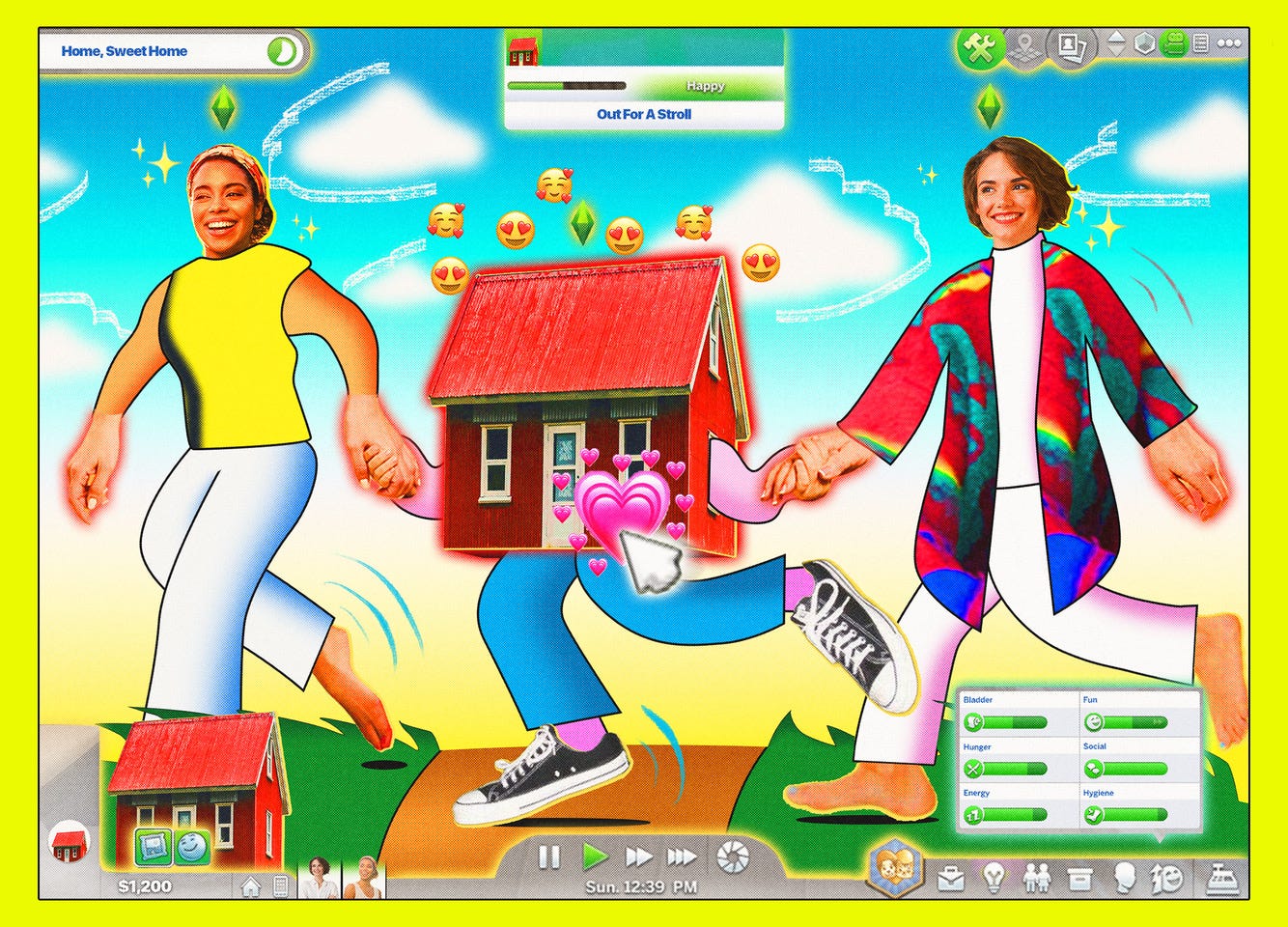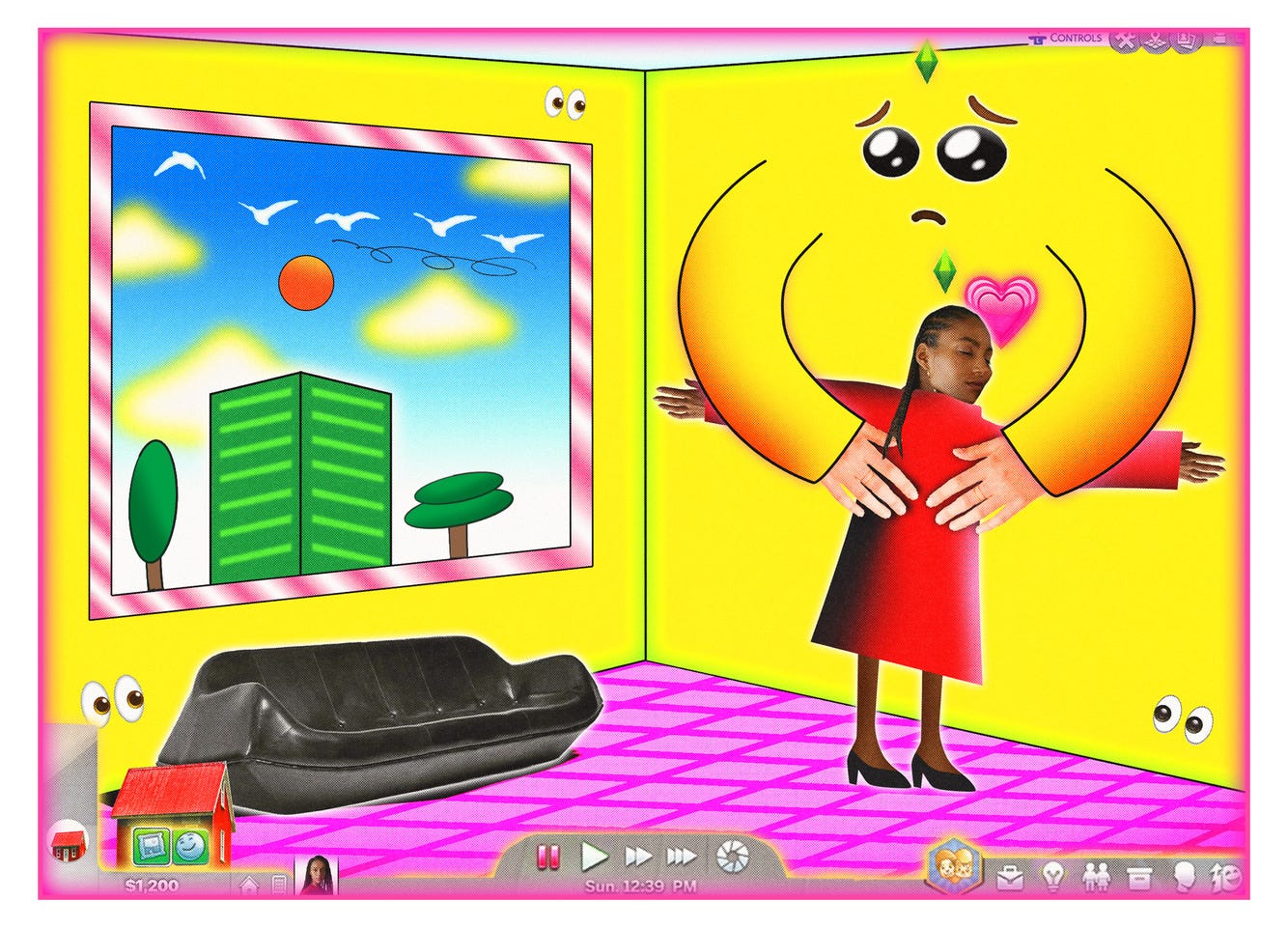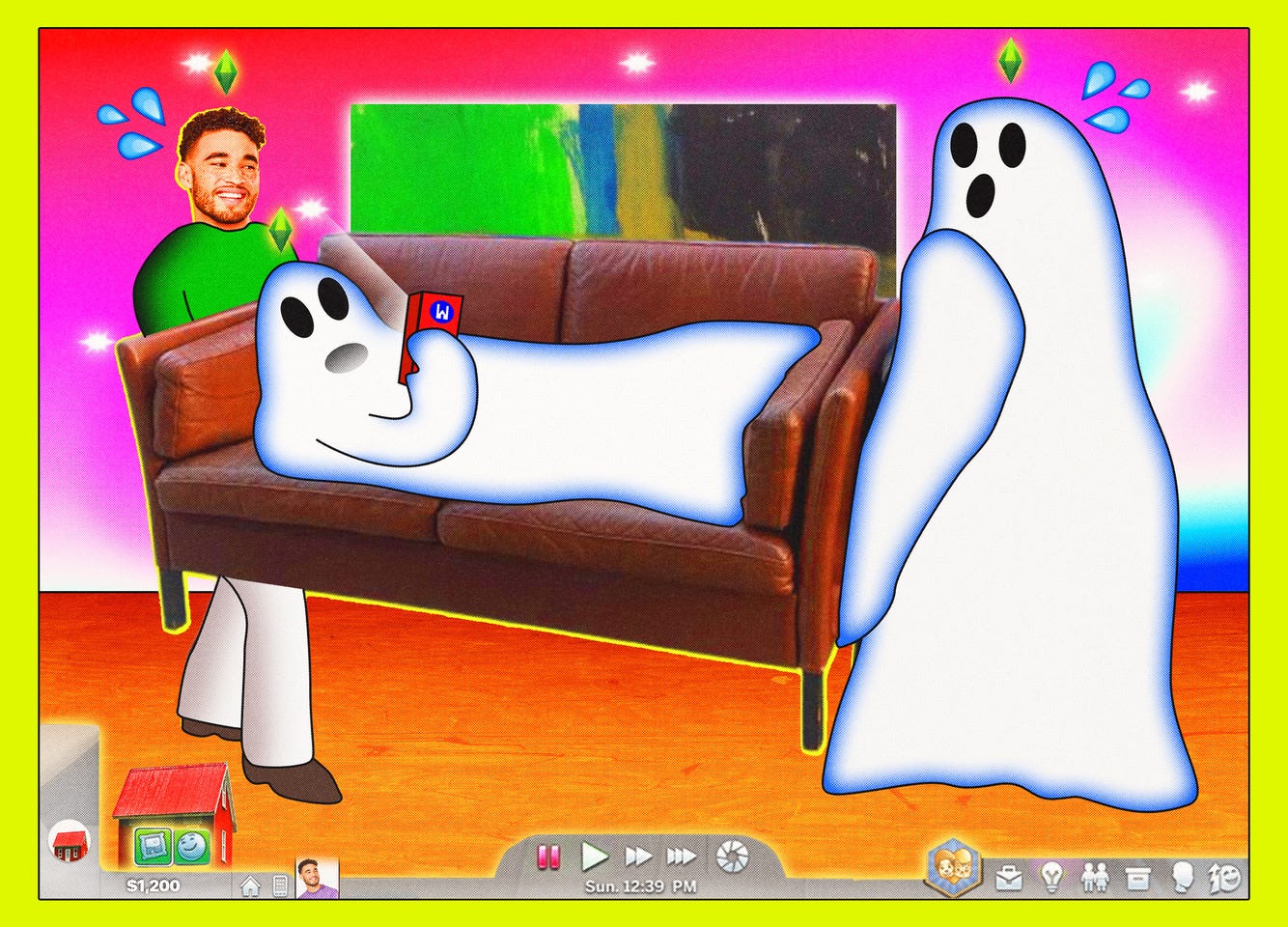Should You Hire An “Energy Architect”?
Three experts share their tools for interior alignment.
By Sydney Gore
During my time on staff at Architectural Digest, I was tasked with coming up with all sorts of content for the “AD It Yourself” vertical. I didn’t have a DIY bone in my body, but my manager encouraged our team to really think outside the box. So, I found myself pushing for the most unconventional stories I could assign. My instincts took me straight to esoterica: explainers on what to do if your house is haunted, interviews about the process of grief cleaning, and advice for warding off bad energy in your home.
These stories seemed to resonate with our readers. Even though they may have been considered “fringe” by some, there was clearly an appetite for this kind of storytelling. The pandemic was hardly in the rearview mirror, so I suspected that the increased interest was part of recovering from the trauma of that period. The revolution might not be televised, but the vibe shift was taking an emotional toll on us all with every twist and turn on the downward spiral.
Aja Daashuur, founder of Spirit House Collective, sees a relationship there as well, attributing the surge in demand for these services to life in quarantine. “It forced us to be in our homes, but also to have the time to evaluate what we were feeling in our homes in a controlled vacuum,” she says. “It took people to a place of ‘My home is more than just four walls and a roof, how can I make that work for me?’ I think that shift is still prevalent.”
Daashuur has been working as a professional spirit guide coach since 2016. The California-based medium and certified past life regression integrator began offering energy mapping as a service in 2022 to help clients connect to the spirit of their homes. The process involves creating a road map to bring positive energy in, identifying what needs to be cleared away, and blessing the space.
Similarly, Danielle Mercurio decided to make energy work and home attunement the forefront of business this year. The self-described energy architect, coach, and intuitive specializes in intentional living by clearing, restoring, and aligning spaces. For her, the motivation is rooted in a question: What is the story of the space, and what does it have to tell me?”
Mercurio’s pivot into this line of work stemmed from a 31-month stint of nomadic living. While moving from place to place, she noticed how quickly she was able to tap in and align a home with her own intentions. After cleansing spaces for friends and family, Mercurio felt called to do this work in a more “forward-facing way” from her new home in Austin, Texas, in 2021.
“Now more than ever, there’s so much going on, and we’re disconnected in so many ways,” she says. “We’re not fully allowing the home to hold us and we’re also not realizing that the home is a reflection of who we are. If we can get into energetic alignment with where we’re living, then that actually extends out beyond the home and into our lives.”
Paige Geffen has been weaving her somatics background into her interior design practice since 2017. (She previously worked as an assistant for Jeremiah Brent before going off on her own.) The Object & Us founder has recently noticed an uptick in interest in nervous-system work from people becoming more aware of accessible ways to release stuck energy and trauma from the body. “Our spaces affect us,” she says. “They impact how we live and how we do everything, so that’s always been my approach to design.”
As a diagnosed empath, I’m more open to unconventional approaches compared to the average person, but I err on the side of caution when exploring the world of “woo-woo.” For anyone who is craving more comfort in their humble abode, there’s great power in turning inward. And as far as makeovers are concerned, what harm could possibly come from realigning your home’s chakras? I spoke with Daashuur, Geffen, and Mercurio to get their sound advice for embarking on the journey.
Get clear on your goals and intentions
At some point in life, you’ve probably been fed word salad about finding your why. But where energy is concerned, this idea especially holds power. “When a client reaches out to me, the first thing I ask is what their hopes and intentions are within the home,” Daashuur says. “The second question I ask is if they’ve connected with their home and asked it what it wants, because I do believe it’s a collaboration with the house.”
In her work, Geffen guides clients through understanding the symbiotic relationship between themselves and their spaces. “The more that we are in tune with our soma, our inner awareness, and our bodies—even going into trauma and releasing these things—and the more authentic [our expression] is, the more we can become in tune with how we want to relate to our spaces, whether it’s being more efficient, productive, happier, or comfortable,” she says. “It’s good to notice what soothes our systems and how we work best so that we can live more comfortably in our spaces.”
When working on interior design projects, Geffen has clients fill out a questionnaire that digs deep into the core of what they want and need in their life so she can project an authentic reflection within the design of their space. “Instead of showing me an inspiration image or a Pinterest board, we start by looking at energetics,” she explains. “So, if someone is trying to bring more structure or abundance into their life, we go in deep about what they’re trying to bring in energetically. That’s how the design process starts… I’m very mindful of designing the space for the direction they’re trying to go in their life.”
Connect with your space
There are missed connections and then there are disconnections. From Daashuur’s point of view, there’s nothing worse than being disconnected from your home space because it “not only affects you, but can also ripple out into whatever you wish to do.” While there are hacks to hold us over, quick fixes won’t repair the deep wounds that might be buried within the foundation of a space—so be prepared (and willing) to do the work.
“You can bring in new furniture, or you can have someone come in and say ‘You need to put this here and that there,’ but if you’re not clear on why there’s a disconnect, it’s not going to fix anything,” Mercurio explains. “It’s so important when you move into your home, before you get furniture in there and worry about artwork and all those things, to connect with the home. Connect with the walls—like, say hello. It’s a funny thing to say out loud, but saying hello to your space and introducing yourself is actually a game changer.”
Mercurio emphasizes that people should take the time to notice how they feel when they walk through the door and take stock of what their space is reflecting. “Does it feel like a hug? Does it feel like you can exhale? If it doesn’t, then that’s what I want you to explore; that means that something’s off,” she adds. “That doesn’t mean that it’s bad, it just means that there’s an opportunity.”
Listen to what the spirits are telling you
Have you ever gone to a flea market and felt like an object was calling you? Was the bond so strong that you couldn’t deny taking it home with you? Daashuur uses this as an example of getting in touch with spirits that “know they can add some value” to your life. In return, we act as the guardians to these pieces, so it’s important to clear them from previous attachments as “we’re not always aware that something [has] shifted” in our home.
And if you’re not listening to your guides, you might have bigger problems on your hands. “It’s not just interior design,” Mercurio says. “Is there energy on the land that I need to be aware of? How am I recognizing the energy of the land? Are there spirits that need help to move on? Are there spirits or ancestors that I want to be calling in? Are my spirit guides engaged with what I’m doing here?”
Similar to clients in the design world, spirits in the other realm can be very demanding. According to Daashuur, some spirits might have a specific color or pattern preference that they want us to take into consideration. “Whether you’re psychic or not, you can feel what your home is asking for,” she explains. “It could be asking for more time. It could be asking to be cleared out. It could be asking for the windows to be open.” And if you don’t have a relationship with your home, she says, this is a great place to start. “It really becomes what I feel this work is about, which is collaborating with the spirit of where you live to create an environment that can help you expand and to receive more joy.”
Get to know your home’s energy
Mercurio thinks that the biggest misconception about energy work is that it’s another form of ghostbusting. “I’ve worked with homes where there have been spirits there, but what’s interesting is it’s more than that,” she points out. “A lot of times people think their home is haunted, but it’s haunted by some energy that’s still living—it could be the energy of grief, it could be sadness, it could be depression. It feels haunting so you might think it’s a ghost, but really it’s something within you that needs to be cleared.”
In fact, problem solving is at the center of energy work. Geffen, for one, recently had a client who insisted that the energy in her bedroom felt “dark and dense.” Sensing the vibes were off—she presumed, due to a ghostly presence in the home—the homeowner brought in someone else to clear the space, but was told that it had “really clean energy.” In response, Geffen prompted her client to consider what made this room so different in comparison to others in the house, and they were eventually able to get to the root of the problem.
“It was the way the bed was oriented toward the door—there wasn’t as much light coming in,” Geffen notes, and the result was that the client didn’t feel comfortable relaxing there. “Of course, it’s energetic, but it was mostly things that we can work [out] visually to make her feel more comfortable,” she says. “I’m helping her to understand where she is in her life, what’s going on with her body and her system, and how she can relate better to her space so she can source differently.”
Energy is valuable
While some of Daashuur’s clients want a simple house blessing to refresh their space, others are repeat customers seeking the divine. “I do yearly clearings for big real estate companies where their whole offices are cleansed, and I’m clearing every single chair, desk, and doorway, and then I’m adding certain crystals or flowers for abundance,” she says.
Daashuur’s pricing varies based on square footage, the amount of time required to clear the space, and whether the service is performed virtually or in person, with rates running from $500 for a studio apartment to $20,000 for a mansion. Geffen is very critical of spiritual materialism, but believes in helping people tap into authenticity by exploring the portals that surround them. The designer tailors her pricing and packaging depending on the needs of the client. “It’s more interesting to flip that model on its head, where it’s really about helping people to get more in touch with their true selves,” she explains. “When I’m doing somatics, it’s bridging [the physical and the metaphysical], but through the body. If we think of objects like ‘This is a vessel,’ rather than ‘This is something I’m just looking at that is sitting in my house,’ it can be a portal to something else, even if that’s a connection to the self or a connection to someone else.”
Mercurio has noticed that many people don’t fully grasp the depth of the energetic assessment involved in her work. When taking inventory of a living space, she’s not just looking at the physical environment—she’s identifying where there’s misalignment in her clients’ lives and exploring ways to make them feel better. While the idea of “energetic architecture” is still new to many, Mercurio sees it as a worthwhile investment for anyone looking to improve their home environment.
Daashuur acknowledges that everyone is learning along the way, but hopes that professionals in this space are setting their rate based on experience and expertise. “You don’t want the client to be paying for your learning curve, but with a lot of this work—whether it’s energy mapping, reiki, or mediumship—there’s going to be people that feel the prices are too high,” she adds. “There’s also going to be people that overcharge.”
Everyone can do it
Even though she’s passionate about doing this work, Daashuur wants people to feel empowered to do it on their own, too. She recommends starting with “magical housekeeping practices” like floor washing, smoke cleansing, and hanging sandalwood over the door. “It also feels good in the body to be an active participant in creating that sacred space,” she adds.
Mercurio reminds us not to dismiss the power of our own hands. “Our hands are tools,” she says. “If a place is feeling stagnant, clap in the corners, wave your arms around like your room, and energetically clear things out through the window. Give your own body more credit as an actual tool.”
Mercurio also recommends buying ethically sourced cleansing tools like palo santo, citrine, cedarwood, and fresh pine that will bring elements of nature into your space along with life, vitality, and richness. “If you feel energetically drained, if you feel like you don’t know what to do, then do something in your space,” she says. “Clear a room, wash the dishes, declutter that drawer. It gives your mind something to focus on and makes you feel purposeful, which then in turn makes you feel more alive and less hopeless. It has a bigger ripple effect than we realize.” A cleared entryway is a great place to start.
Vessels can also help you build a relationship with your space, too, says Geffen. Petite or monumental, the size doesn’t matter—it’s all about the empty space inside of them. “I think of that as room for you to energetically fill up yourself,” she explains. “Finding a vessel in your space and holding it against your body creates an awareness… We start with the internal body and then work with objects and the texture of things and how that affects you. That’s how I also help people notice what they like, what they gravitate towards, and what makes them feel good or a certain way.”
Mercurio enjoys teaching professionals—including interior designers, stylists, and real estate agents—how to use these methodologies with integrity. “I feel like there’s such an opportunity to bridge them, and that’s definitely where my head is at,” she says. “How do we get this tool and this framework to more people so that we’re bringing it to the home space?”
At the end of the day, everyone needs to determine their own personal relationship with these practices. “I think there used to be this feeling of ‘I have to be an interior designer, I have to be good at decorating,’ but it’s not really about that,” Mercurio adds. “It’s about these little shifts that all of a sudden open up your space which then open up your perspective.”
Home is a sacred space
Now that more people are aware of how much their home environment affects their well-being, the demand for energetic architecture and home attunement has never been higher. “When I was doing this work for clients, they were saying—and that’s from a 5,000-square-foot office building to a 30,000-square-foot mansion—like ‘How can I feel that I’m a conduit of magic here?’ I think that’s going to continue to be happening because the relationship with our home has really shifted since lockdown,” Daashuur says.
Even though the quarantine days are far behind us, the experts in this story believe that the learnings from those days should remain top of mind. Mercurio says it’s a disservice to not treat the home like an extension of ourselves, especially given that it plays such a prominent role in our lives, and encourages people to be more proactive about seeking out new approaches to alignment.
“Our homes are looking out for us more than we realize—so when you’re feeling confused or lost, look to the home to give you insight, to give you clues,” she concludes. “Notice how you feel when you walk out the door. Notice how you feel when you leave. Notice how you feel when you go on a vacation and it’s time to come home. Are you dreading it or are you excited to get back to it? Those are all clues and intel that we can utilize.”
For her part, Geffen hopes more people recognize that a home’s beauty is never just about visuals—we should be willing to dig deeper, and engage with what’s beneath the surface. “With all of the horrors in the world, from genocide to climate change, we need beauty and grounding,” she says. “It can help us to come back to ourselves, make better decisions, and engage with the world in a better way… There’s something much deeper going on than just what you’re looking at and it can be transformative.” ⌂
Sydney Gore is a writer, editor, journalist, and consultant bringing a fresh perspective to the table through dynamic stories that are shifting the culture.





